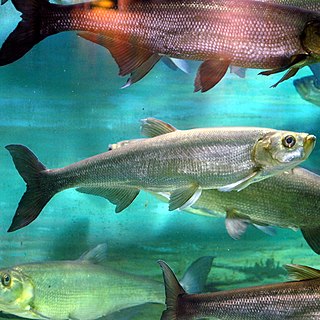
The term carp is a generic common name for numerous species of freshwater fish from the family Cyprinidae, a very large clade of ray-finned fish mostly native to Eurasia. While carp are prized quarries and are valued as both food and ornamental fish in many parts of the Old World, they are considered trash fish and invasive pests in many parts of Africa, Australia and most of the United States.

The Chao Phraya River is the major river in Thailand, with its low alluvial plain forming the centre of the country. It flows through Bangkok and then into the Gulf of Thailand.

Cyprinus is the genus of typical carps in family Cyprinidae. Most species in the genus are of East Asia origin with only the common carp in Western Asia and Europe; this invasive species has also been introduced to many other regions around the world. Cyprinus are closely related to some more barb-like genera, such as Cyclocheilichthys and Barbonymus (tinfoils). The crucian carps (Carassius) of western Eurasia, which include the goldfish, are apparently not as closely related.

The barramundi, Asian sea bass, or giant sea perch is a species of catadromous fish in the family Latidae of the order Carangiformes. The species is widely distributed in the Indo-West Pacific, spanning the waters of the Middle East, South Asia, Southeast Asia, East Asia, and Oceania.

The otter civet is a semiaquatic viverrid native to Thailand, Malaysia, Indonesia and Brunei. It is believed to be undergoing severe population decline due to habitat destruction and is classified as an endangered species by the IUCN Red List.

The Chinese pond heron is an East Asian freshwater bird of the heron family, (Ardeidae). It is one of six species of birds known as "pond herons". It is parapatric with the Indian pond heron to the west and the Javan pond heron to the south, and these three are presumed to form a superspecies. As a group they are variously affiliated with the squacco heron or the Malagasy pond heron. As of mid-2011 there are no published molecular analyses of pond heron interrelationships and osteological data is likewise not analyzed for all relevant comparison taxa.

Basa, as it is commonly referred to, is a species of primarily freshwater-dwelling catfish in the shark-catfish family, Pangasiidae, native to the Mekong and Chao Phraya river basins of Mainland Southeast Asia. Economically, these fish are important as a regional food source, and are also prized on the international market. Outside of Asia, such as in North America or Australia, they are often referred to as "basa fish" or "swai" or by their specific name, "bocourti". In the United Kingdom, all species of Pangasius may, legally, be described as "river cobbler", "cobbler", "basa", "pangasius" or simply "panga", as well as any of these names with the addition of "catfish". In the rest of mainland Europe, these fish are mostly sold as "pangasius" or "panga". In Asian fish markets, names for basa also include "Pacific dory" and "patin". Other, related shark-catfish species may occasionally be labeled—albeit incorrectly—as basa, including the iridescent shark and the yellowtail catfish.

An anchovy is a small, common forage fish of the family Engraulidae. Most species are found in marine waters, but several will enter brackish water, and some in South America are restricted to fresh water.

The Indian mackerel or bigmouth mackerel is a species of mackerel in the family Scombridae. It is commonly found in the Indian and West Pacific oceans, and their surrounding seas. It is an important food fish and is commonly used in South and South-East Asian cuisine.
Anabarilius andersoni is a species of freshwater ray-finned fish belonging to the family Xenocyprididae, the East Asian minnows or sharpbellies. This species is endemic to China. It is a pelagic species only known from Xingyun Lake in Yunnan, and its population is severely impacted by domestic pollution and overfishing.
Anabarilius liui s a species of freshwater ray-finned fish belonging to the family Xenocyprididae, the East Asian minnows or sharpbellies. The nominate subspecies liui is endemic to the upper Yangtze basin in China, but there are no recent records and it is considered extinct in the 2009 Chinese red list.
Anabarilius xundianensis is a species of freshwater ray-finned fish belonging to the family Xenocyprididae, the East Asian minnows or sharpbellies. It is endemic to Yunnan (China). It is known from Qingshui Lake in the eponymous Xundian County, on the Jinsha River. The exact threats are unknown but it may be fished for food and sensitive to pollution.

The Cultrinae are one of at least 13 subfamilies of cyprinid fish. It contains ten genera.
Pseudolaubuca is a genus of freshwater ray-finned fish belonging to the family Xenocyprididae, the East Asian minnows or sharpbellies. These fishes are found in East Asia.

The Japanese Spanish mackerel, also known as the Japanese seer fish, is a species of true mackerel in the scombrid family (Scombridae). Their maximum reported length is 100 cm, and the maximum reported weight is 10.57 kg.
Pseudohemiculter dispar is a species of freshwater ray-finned fish from the family Xenocyprididae, the East Asian minnows and sharpbellies, from south east Asia. It occurs in the Mekong and Nam Ma basins in Laos, central and northern Vietnam, and southern China.
Pseudolaubuca engraulis is a species of freshwater ray-finned fish from the family [[[Family (biology)|family]] Xenocyprididae, the East Asian minnows or sharpbellies. It occurs in the Zhu Jiang, Yangtze, Yellow rivers and their drainages in China.
Pseudolaubuca jouyi is a species of freshwater ray-finned fish from the family [[[Family (biology)|family]] Xenocyprididae, the East Asian minnows or sharpbellies. It occurs in South Korea.
Pseudolaubuca sinensis is a species of freshwater ray-finned fish from the family [[[Family (biology)|family]] Xenocyprididae, the East Asian minnows or sharpbellies. It occurs in China and Vietnam.











